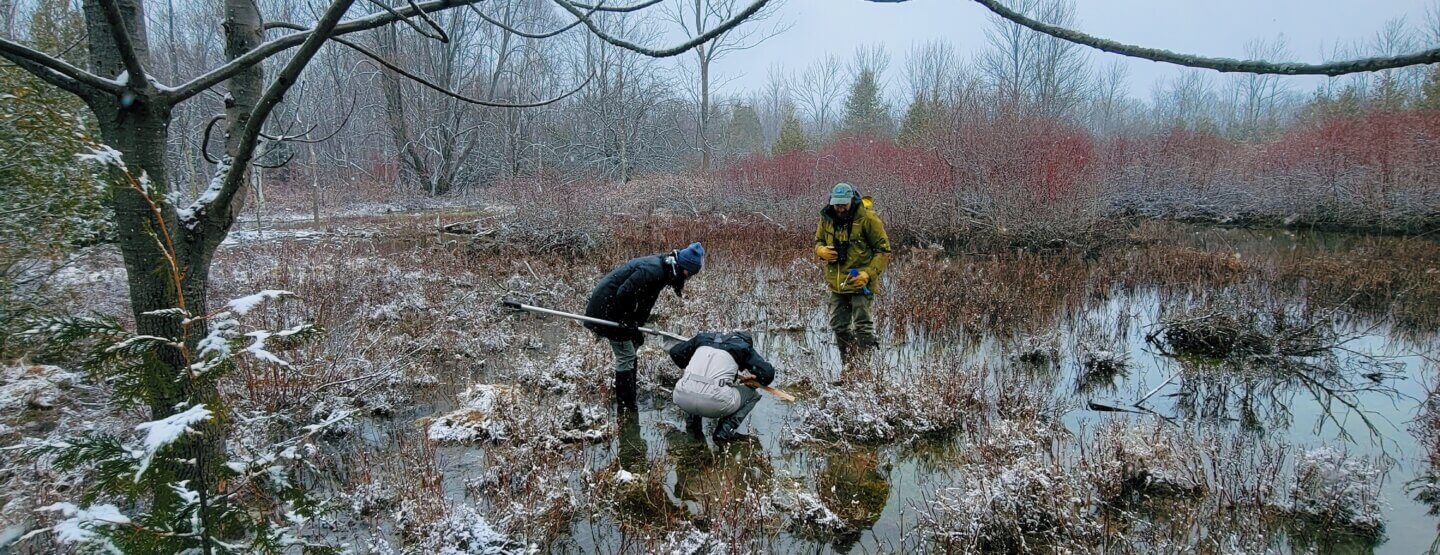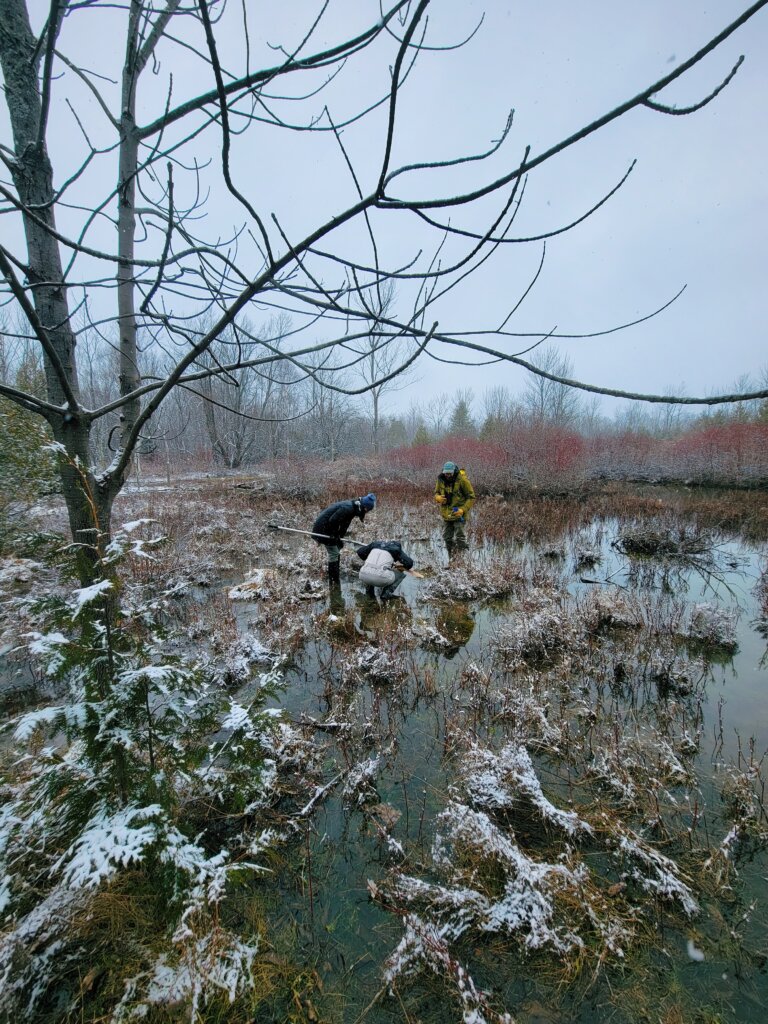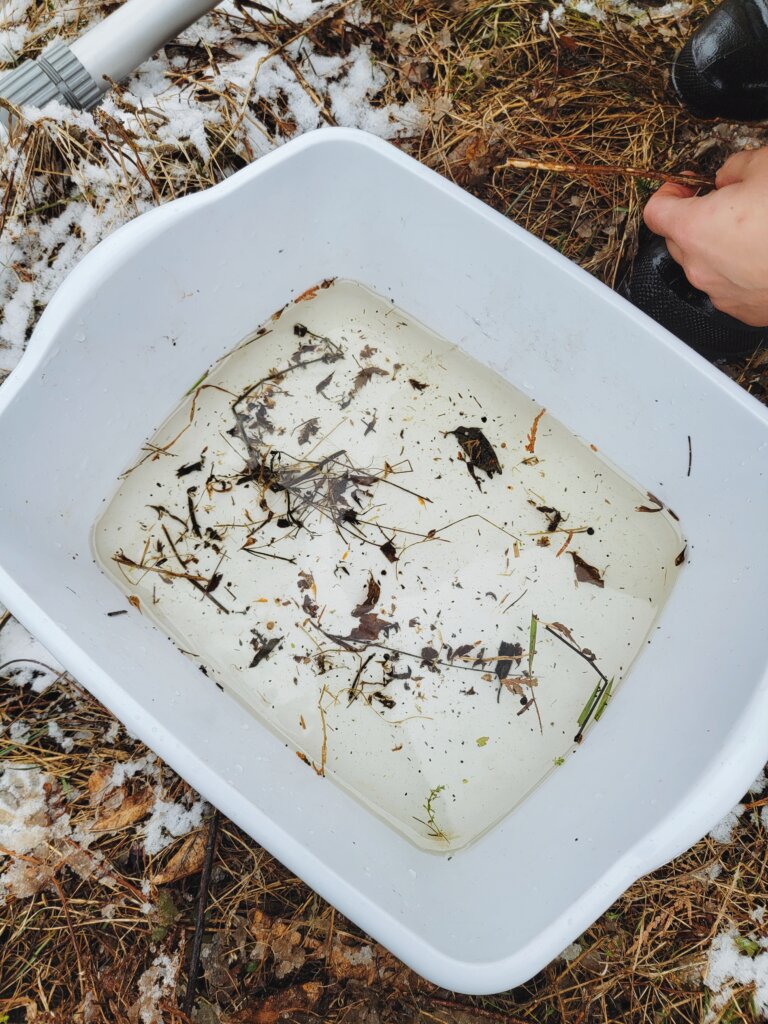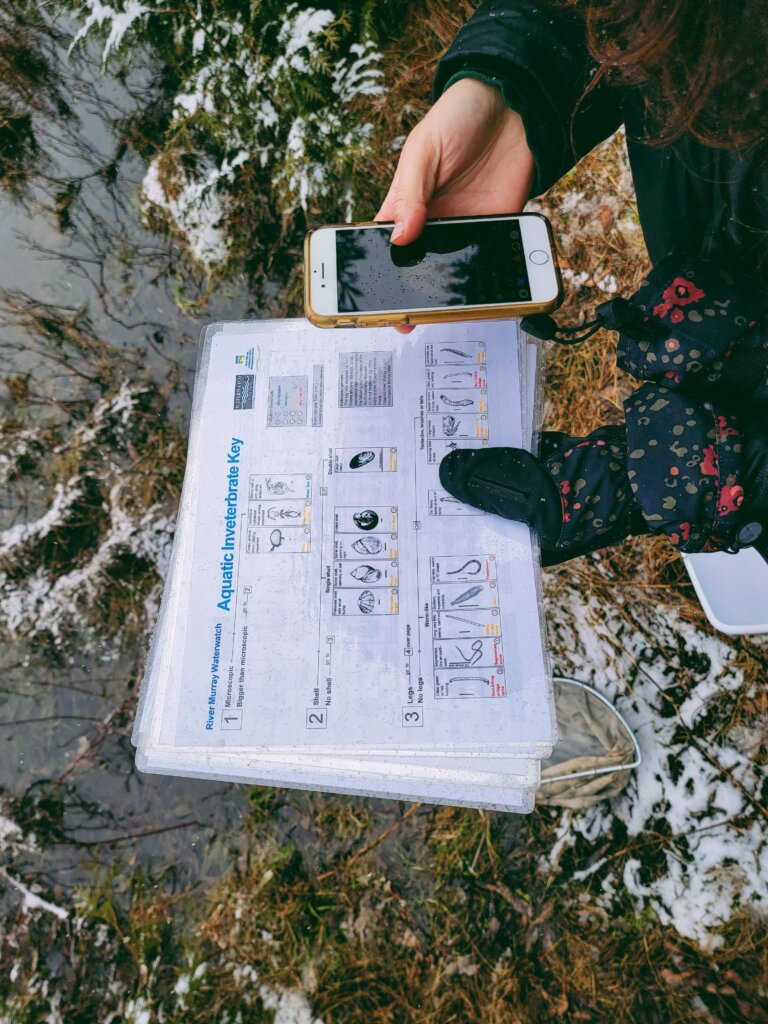Spring in northern Michigan feels like biding time until summer. We still experience frost and snow. Rain stretches from the end of March through May. We make do with the gray skies and muddy ground because we know that long days of sunshine come after the rain. However, a lot happens in the natural world during this transitional time. As temperatures begin to rise slowly, leftover snow melts, and the ground softens. Water collects in concave dips in the land and creates vernal pools. These ephemeral wetlands are wondrous worlds filled with unique and necessary wildlife.
On a chilly April morning, Land Steward Caleb Garone and Conservancy AmeriCorps members Katelyn Maylee, Emma Somers, and LeighAnna Peck set out to monitor a vernal pool within Lighthouse West Natural Area. Katelyn leads the group, walking the trail with a digital map. She stops and looks to her right, “We’re going that way,” she points to the woods. The crew duck and climb through snowy cedar branches until coming to a clearing where the vernal pool ripples silently. “If it were warmer, you’d be hearing a lot more sound from wood frogs,” Katelyn says. “But because it’s cold out today, they’re hiding away.”
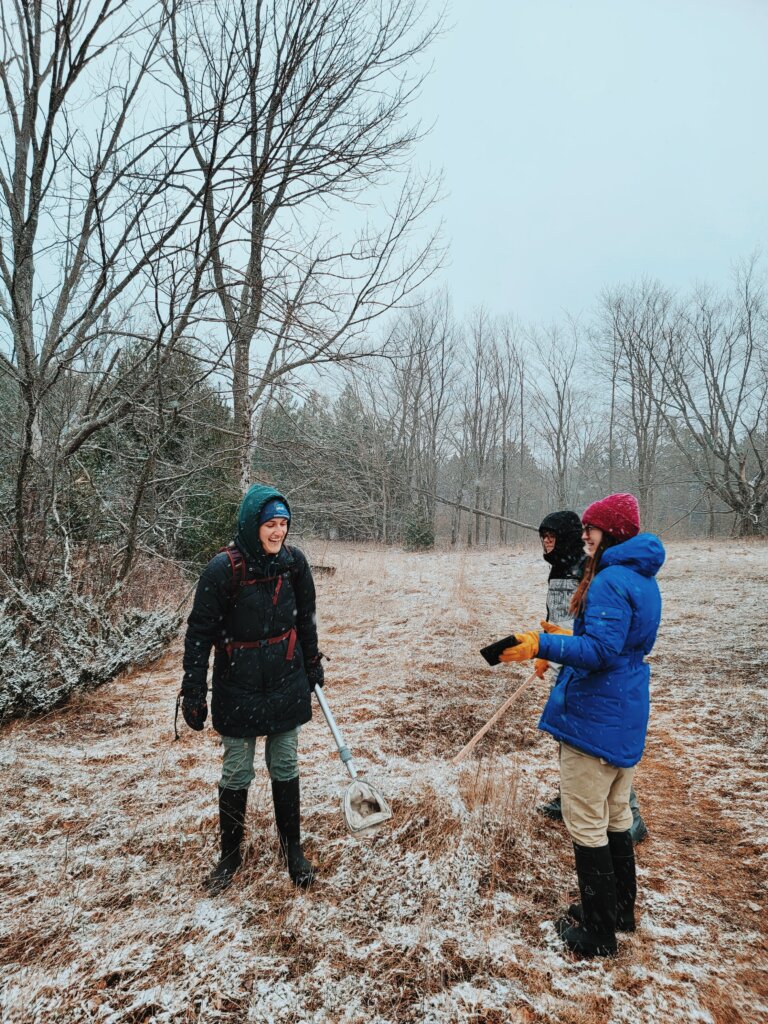
The crew wades out into the water, each with a different task. Equipped with a measuring stick and temperature monitor, Caleb and Katelyn move to the deepest point in the water. On the other side of the pool, Emma rakes a longhandled net through shallow water. In the distance, LeighAnna walks the perimeter lifting logs and gently placing them back down as they were, searching for salamanders. Vernal pools in Michigan have mainly formed by floodplains, glaciers, and sag ponds. When groundwater winnows away tiny pockets of limestone deep in Leelanau’s soil, it creates a divot, or sag pond, in the surface land that makes a great prospective vernal pool. At a glance, vernal pools look pond-like. They’re shallow, typically small bodies of water. What separates them from ponds is their lifecycle and the species that inhabit them. Vernal pools go through a three-part lifecycle every year; wet, flowering, and dry.
In Michigan, over 100 species of invertebrates have been found in vernal pools, and 24 amphibian species. Over half of vernal pool amphibian species use the pools in their breeding cycle. The Michigan Natural Features Inventory (MNFI) is collecting data all over the state through their Vernal Pool Patrol program. The program offers a training on how to properly identify, map and monitor a vernal pool. Interested individuals and organizations that complete the training provide information to MNFI so the pool can be mapped and the data can be stored. The Conservancy is the Leelanau County partner for this program. This year we monitored four vernal pools in the county.
If the vernal pool lifecycle were a three-act play Part I would be the wet phase. Towards the end of winter and at the beginning of spring, vernal pools begin to fill with water. Rainwater and melted snow collect in the basins and fluctuate throughout spring. Each pool has a different hydroperiod based on size, temperature, and precipitation levels. As the water levels rise, vernal pool species come alive. Blue-spotted salamanders, wood frogs, spring peepers, fairy shrimp, fingernail clams, and more magical sounding creatures call the pool home while carrying out their reproductive cycles. The amount of time the pool is wet significantly impacts which species will thrive. For example, fairy shrimp only need a month to mate and release eggs into the water. Spring peepers have a more extended mating season and require more time for laid eggs to hatch.
By early summer, the water from vernal pools is almost gone. Left behind is damp, sometimes muddy soil and lush vegetation. Some of the vernal pool creatures hatched when water was still abundant, but other species’ eggs will continue to dry out with the pool, only to hatch next year when the pool fills again. The saturated ground provides an excellent base for native flora to thrive. Vegetation in vernal pools differs from its surrounding uplands because of its unique conditions. Vernal pools provide a safe place for amphibians and insects to lay their eggs. “It’s not a vernal pool if there’s fish in it,” says Katelyn. Wood frog and bluespotted salamander eggs would be quickly eaten up if there were.
The vernal pool has reached its dry phase as summer ends and fall begins. By now, it’s dried up along with all the eggs, plant life, and seeds within. The pool looks seemingly unremarkable as leaves fall and cover the once lively set.
Emma scoops a couple of water samples into a white bin and brings it to shore. She crouches down to look at her findings. To the untrained eye, the water in the container looks like nothing more than swamp water with sticks and debris. A closer look reveals a tiny world bustling with life. Small, orange crustaceans known as fairy shrimp move through the water via their rippling appendages. They’re perhaps the most prominent indicator that a body of water is indeed a vernal pool. Their lifecycle requires their eggs to dry out before rehydrating fully. Emma grins as she holds up a fingernail clam on her fingertip. “Good haul Somers,” Katelyn says over her shoulder. She and Caleb have returned with their recordings, including the temperature and deepest point measurements.
Within this unique ecosystem are obligate (or indicator) species and facultative species. Obligate species are the flora and fauna that rely on vernal pools to carry out their lifecycle. Included in obligate species are wood frogs, spotted salamanders, blue-spotted salamanders, Jefferson salamanders, and fairy shrimp. If they’re not present in or near the water, it cannot be considered a vernal pool. Facultative species are wildlife that benefit from a vernal pool’s resources but are not reliant on them. Some of these creatures use the pool for breeding; others use it as a convenient snack shack filled with delectable amphibian and insect eggs. Examples include red spotted newt, northern spring peeper, American toad, wood turtle, and spotted turtle.
Vernal pools influence wildlife through the food chain. Deer will munch on growing vegetation and grasses, and birds eat eggs and insects. California was once rich with vernal pools. It’s estimated that they’ve lost 90 percent or more due to agricultural expansion and urban development. This rare wetland habitat has declined further due to continued development in recent decades. The U.S. Fish and Wildlife Service finalized its Recovery Plan for Vernal Pool Ecosystems of California and Southern Oregon in 2005 to address and prevent more loss. Out of 33 obligate species in the state’s vernal population, 15 are endangered and would go into extinction if the pools cease to exist. The complete loss of vernal pools would have a profound and adverse impact on the rest of California’s wildlife. LeighAnna approaches the crew, huddled around the sample water. “I think there’s another vernal pool attached to this one on the other side,” she said. “Let’s record what we found in this water and then go take a look,” Caleb suggested. They record their findings based on the water sample taken. A questionnaire asks what kind of species were discovered and roughly how many could be found within the pool. After the data is recorded, Caleb and LeighAnna take a walk where they find that there is another vernal pool next to the one just monitored. They repeat the sampling and data collecting on the newly discovered pool before heading back to the work truck. They’ll return midsummer to survey the pools with a more up close look at some of the plant life. One more survey will be done in the fall. Blanketed under snow, the vernal pool will rest until next spring, when the magic will begin again.

